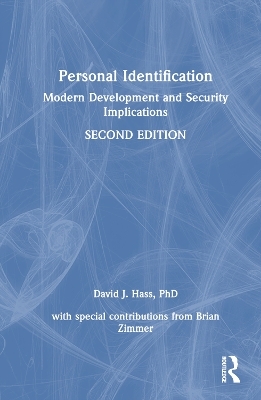
Personal Identification
CRC Press (Verlag)
978-1-032-52374-3 (ISBN)
Personal Identification: Modern Development and Security Implications, Second Edition explains how personal identification – and REAL ID – became part of the American fabric along with their past century’s historical ID development. The development of the “trusted and secure” personal identification documents began with passports and has continued as social changes made IDs more essential. This book describes the convergence of technologies and hundreds of patents that produced our “trusted and secure” documents and IDs from our past right up through to today.
Key factors, that created today’s need for public-issued mass ID, are addressed:
Chronicles the effects of large and mobile populations beginning a century ago
Chronicles the effects of “impersonal” electronic & computer communications at a distance, and
not face-to-face
The distribution of services and money by government agencies based on a person’s identity –
including “age” and “group” criteria
Describes recent national security and terrorism concerns that necessitates the need to know: “You are who you say you are.”
Personal identification documents (IDs) and the societal need for “trusted” identification by the public is a relatively new social phenomenon. In 1900, most people did not need or have any IDs until passports, with a photograph of the individual, became mandatory when Great Britain entered World War I in 1914. In the United States, the State-issued driver’s license is probably the only trusted ID in one’s wallet today, but they became “trusted and secure” documents only recently with the requirement for REAL ID. With the first photo driver’s license issued by the State of Colorado in 1959, it took until 1984 for the last State (New York, 25 years later) to comply.
As a direct result of 9/11, where terrorists used fake driver’s licenses to board planes, Congress passed the Real ID Act in 2005 to make all State-issued driver’s licenses more trusted, uniform, and tamper-resistant – what is now called the Enhanced Driver’s License with non-drivers being issued Enhanced Identification Cards. And with this, every US citizen can now possess a trusted and secure personal identification document.
Personal Identification, Second Edition chronicles the path of personal identification measures – including the latest developments of Real ID. Scholars and professional security managers understand that stability, security, and safety necessitate these identity measures to ensure a safer America. The book explains the various stages and advances, providing readers with a unique study of this fascinating history of the relationship between identity and the means by which one validates and proves their own identity. The enactment of the REAL ID Act of 2005, with more secure and tamper-resistant documents for each citizen of the United States, is being instituted so that one can trust: “you are who you say you are.” The State-issued driver’s license is not a National ID Card – it is a Nationally Recognized ID for each citizen.
David J. Haas received his BA in Physics and PhD in Biophysics at the State University of NY at Buffalo. For the next five years, he performed basic research in protein crystallography at several institutions in Europe and the United States. This basic research led to liquid nitrogen cryo-cooling, whereby macromolecular crystals reduced radiation damage during X-ray analysis. Whereas this technique was years ahead of its time, today cryo-crystallography is used at every Synchrotron worldwide for Structural Biology. In 1970, he joined Philips Electronic Instruments in Mt. Vernon NY as principal X-ray scientist, designing some of the first airport X-ray scanners used worldwide during the 1970s. Conceiving the idea of self-expiring visitor badges (changes color in one day to prevent reuse), David and his wife, Sandra, formed Temtec Inc. in 1981 in Suffern NY, and manufactured visitor and temporary IDs for more than 20 years under the brand name TEMPbadge. The company was sold in 2002. Besides many scientific papers and articles, David and Sandra have dozens of patents to their credit. The first edition of his book Personal Identification – Its Modern Development and Security Implications was published in 2009 by ASIS Intl. and has been updated substantially with this second edition. Brian Zimmer has been President of the Coalition for a Secure Driver’s License (CSDL) since July 2007, and Keeping Identities Safe since 2012. He has published numerous articles, been cited in newspapers, and has spoken to social and political organizations across the United States as an expert on driver’s license security. He has testified before legislative bodies in more than a dozen States regarding the REAL ID Act and before the US Senate on border security. In 1995, Mr. Zimmer was recruited from the Department of Interior Office of the Secretary to the US House of Representatives’ Offices of Procurement. As the Director of Information Technology Procurement, he led the installation of modern IT infrastructure at the House buildings, including the implementation of a new financial system and integrated procurement system. From 2001 through 2006, Brian Zimmer served as Senior Policy Advisor and Investigator for the Committee on the Judiciary, US House of Representatives.
1. Personal Identification and Its Components 2. The Evolution of Personal Identification: from Prehistory to the Twentieth Century 3. The “Trusted” ID: its Invention and Reality 4. Trusted ID Example 1: the Passport and “Function Creep” 5. Trusted ID Example 2: National Identity/ Health Insurance/ Driver’s License Cards 6. Trusted ID Example 3: the State-issued Driver’s license (before REAL ID) 7. Trusted ID Example 4: the REAL ID Driver’s Licenses and Enhanced Driver’s License 8. Historical Development of IDs: “Authorization” Lapel Buttons, Pins and Badges 9. Laminated IDs (with Photographs) Resulted from World War II 10. Modern Plastic Cards for the Public, Government & Business 11. How “Asis International” Provided a Forum for Shaping Personal IDs 12. The New Digital World of Personal Identification and Documents 13. Convergence into IDs: Numbers, Access Control and Biometrics 14. The End of Self-Identification in America
| Erscheinungsdatum | 06.03.2024 |
|---|---|
| Zusatzinfo | 27 Tables, black and white; 5 Line drawings, color; 2 Line drawings, black and white; 43 Halftones, color; 23 Halftones, black and white; 48 Illustrations, color; 25 Illustrations, black and white |
| Verlagsort | London |
| Sprache | englisch |
| Maße | 156 x 234 mm |
| Gewicht | 2040 g |
| Themenwelt | Recht / Steuern ► EU / Internationales Recht |
| Recht / Steuern ► Strafrecht ► Kriminologie | |
| Sozialwissenschaften ► Politik / Verwaltung | |
| Sozialwissenschaften ► Soziologie | |
| Wirtschaft ► Volkswirtschaftslehre | |
| ISBN-10 | 1-032-52374-3 / 1032523743 |
| ISBN-13 | 978-1-032-52374-3 / 9781032523743 |
| Zustand | Neuware |
| Haben Sie eine Frage zum Produkt? |
aus dem Bereich


